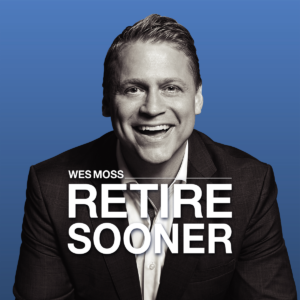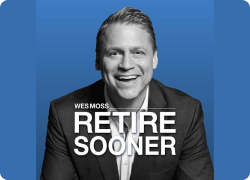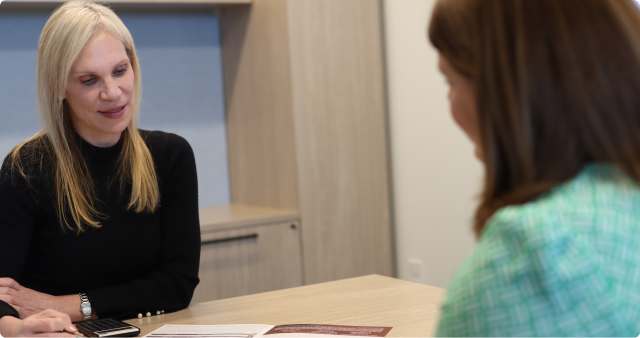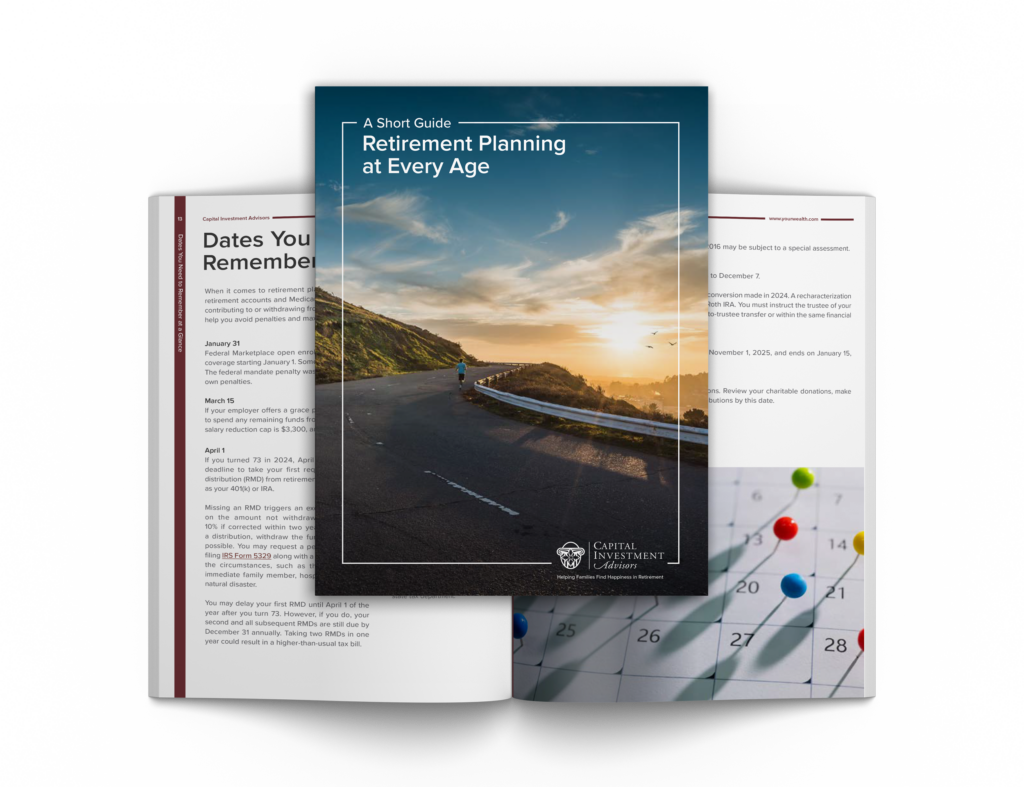Learn how to optimize your retirement planning by utilizing essential financial tools. Discover strategies for leveraging a COLA-adjusted pension, navigating 403(b) withdrawals while contributing to a Roth IRA, and minimizing taxes. Explore rolling I bonds into a 529 plan without triggering taxable events.
Analyze switching funds while managing a 401(k) or how Fidelity’s BrokerageLink might provide low-fee options without incurring taxes or penalties. Understand how to make the most of your retirement plan without worrying about tax implications.
Enjoy all this and more as Wes Moss and Christa DiBiase take listener calls, help ease tariff fears, and marvel at the power of the American Army of Productivity.
Read The Full Transcript From This Episode
(click below to expand and read the full interview)
- Wes Moss [00:00:46]:
Let’s get started. Christa Dibias, how you doing?Christa DiBiase [00:00:51]:
Good to see you.Wes Moss [00:00:52]:
Good.Christa DiBiase [00:00:53]:
So today, obviously last week, a lot of volatility. I mean, there’s volatility. We’re gonna expect more volatility probably in the stock market.Wes Moss [00:01:01]:
Sure. And it’s almost a given.Christa DiBiase [00:01:05]:
So you’re gonna kind of tell us how to tariff proof our finances, is that right? I mean, our retirement account proof, I.Wes Moss [00:01:12]:
Would say that’s a little strong. I don’t know if I can tariff proof anything, but I think we can. Really. We can. We. I think I want to address that today because it’s been in the headlines all year and there’s real evidence right now. And there was a report on CNBC recently that showed. And it was from Empower.Wes Moss [00:01:26]:
And Empower is a giant retirement plan company and they have 19 million participants. So it’s a really. They know what’s happening inside for 1k accounts. And what we’ve seen so far in, let’s call it, early 2025, is that people are. They’re making a lot of moves within their retirement accounts. Trading is doubled inside of retirement accounts. And even though you still see 60% or so people that are in target date funds are staying the course. There’s a huge amount of people that have been selling and trying to go into safer assets.Wes Moss [00:02:00]:
So we’ve seen this report from Empower says that 40% of folks have sold stocks or large cap US stocks. And where’s that money going? It’s going into the stable value fund, which is really the same thing as kind of cashing out and just stashing money away. So we know that there’s been huge activity, and it’s really because of all the uncertainty that we’re seeing in 2025. So that is the reality of what’s happening, and that’s the reality of what investors do when when headlines go from normal scary to kind of almost monster scary. And, and I think there’s a couple of things here where I, I have a solution to that. It’s not a proofing of that. Okay, but tariffs and them being the, the, the thought of tariffs being in the headlines, that’s probably going to be with us for a while. It doesn’t look like anything’s getting solved anytime too soon.Wes Moss [00:02:48]:
But a couple of thoughts. One, we essentially saw a 10% correction already in 2025. I go back to the long term chart of the market, and if you look at the last 80 years, you’re going to see every single year there’s a period of time where markets are down because the stock market is certainly not, it’s not an escalator. It doesn’t just go a little bit higher every day. We have fits and starts and fits and starts. And the average for any given year is about 16%. The average normal year, we see a 16% pullback. And what feeds that this? The scary headlines, I think you call them scare lines.Wes Moss [00:03:24]:
Scare lines. And these are the kind of the monsters that make us nervous about the world that we live in. And if you think about the last, call it three or four years, there’s always been a monster theme that has been out there for the media to get as many clicks as they can. And I don’t, I don’t blame the media. I mean, we’re, we’re media here. But the news media really wants to scare you, make you nervous. And you click on something and you read it. And if you go back to 2022, what was the fear? Headline was recession, recession, recession.Wes Moss [00:03:58]:
110% of economists said we’re gonna go into recession. There were hundreds and hundreds and thousands of headlines that said a recession is intimate. Intimate. A recession imminent? I guess it could be. It’s imminent. So that was the cycle in 2022. Then in 2023 and 2024, I think the media and the market got totally obsessed with Fed cuts. The Fed had raised rates too much.Wes Moss [00:04:22]:
Interest rates are high. Mortgage rates are at 7 or 8%. We can’t afford credit card debt. We can’t afford car loans. We can’t afford mortgages because rates are way too high. That was the prevailing drip of fear. And it was all about Fed cuts. And the market was obsessed about it.Wes Moss [00:04:40]:
And we got a few cuts and that, that conversation is gone. By the way, the recession conversation kind of went away. Now we’re into, I, let’s call it the third year And I’m looking back over the main headlines now. We’re in tariff terror 2025. Everything is about tariffs and how they’re going to create, they’re creating uncertainty. The fact that we haven’t figured out what the tariffs are going to be, that’s creating even more uncertainty. And then what is that going to do? The economy and our consumers are going to spend less and our employer is going to lay people off and we’re going to have less employment and then we’re going to spend even less and then we go into a recession. So Tariff Terror 2025 leads into the potential or the worry for recession, which, by the way, there’s always a worry of going into recession.Wes Moss [00:05:24]:
The answer to this, though, and I’m not going to tariff proof, but give us an answer of what happens here. How can you keep investing through all this? And I’ve mentioned here on the show a couple of times this army of American productivity. And really what that means is this, if you think about the workforce that we have in the United States, it’s 170/million people that are going out there every day for a variety of reasons. Some people have to work and they’re scared to lose their job. So they’re doing as best as they can at work. Some people do like their work and they’re there and they get some benefit out of it. And then there’s a portion of folks that really love work and their purpose in life is to make their division of their company or their small business a little bit better every day. And imagine, though, 170 million people doing that every single day.Wes Moss [00:06:16]:
Big companies do it, too. So I think about some of the reactions around tariffs. Well, I think about companies like Hasbro, the giant toy company. Well, they’ve had a ton of their product made in China. Well, what happens if we have even worse tariffs in China? They have been diversifying their supply chain for some time now. They’re going to other countries, they’re going to Vietnam, they’re going to India, they’re going to other places to try to figure out a way to still do their business and still have a net margin and still make money. Apple’s been doing the same thing, Home Depot, Walmart doing the same thing, trying to figure out how do we shift our supply chains so that we’re less impacted by tariffs. It’s just another example is no matter what gets thrown at us, what gets thrown at companies, you got a huge amount of people that are all trying to figure out that maze and still have the business grow, still have prosperity.Wes Moss [00:07:12]:
And I don’t know if that tariff proofs anything, but it certainly is the path that we’ve seen for over 100 years. No matter what problem of the day, year, week, decade gets thrown at companies, they figure out a way to cope with it, deal with it, and thrive no matter what. So to me, I know that we’re in one of those periods of even greater uncertainty. The army of productivity doesn’t get scared out of markets. It keeps going. And neither should we get scared out of our 401ks like we’re seeing in the empowerment numbers. You’ve got to be able to be long term investors and ultimately that’s how we get our gains over time.Christa DiBiase [00:07:52]:
I love that. I learned a lot right there. That was awesome. Like I didn’t know those companies were doing that.Wes Moss [00:07:57]:
And that’s, those are just, that’s the tip of the iceberg. It’s, it’s just a, every company, CEO, management team, leadership team, division head, department head, team lead, they’re trying to figure out how to deal with the cards they’re dealt.Christa DiBiase [00:08:09]:
And by the way, I would put myself in the third camp on people who I really do love my job. Obviously, I think anyone listening would know I’m so lucky to work with Clark, to work with you and that we do something to help people. Very, very lucky. I hope everyone listening feels the same way about their jobs. We’ll go to some questions now. Greg in Alaska says. Hi, Wes, I’m an index fund investor and wanted to know how the s and P500 index gets weighted for its stocks. How do companies like Schwab, Fidelity and Vanguard add the percentage of a single company stock into the fund? Like how does a company like Apple get a higher percentage in the index than a company like Home Depot?Wes Moss [00:08:51]:
This is cool. This is a really good question and it’s so important. It’s like this is a fundamental. I think I’d maybe take it for granted or if you’re an index fund investor, you do take it for granted. But the averages are very different. Now. Most of the big averages, the s and P500, of course, is the biggest representation or the most notable, I wouldn’t say the biggest. The most notable representation of US companies.Wes Moss [00:09:14]:
But then there’s the Russell 1000, 2000, the Russell 3000. And for the most part, those indices, Greg, are made up on a capitalization weighted basis. So very simply, the bigger the company, the bigger the weight. And why this is a question is because not all indexes do that the Dow Jones is totally different. They have a totally different way of doing it. The Dow, which is only 30 companies, also supposed to be representative of the United States general economy. So technology, healthcare, finance, all within the communication, all within the Dow. But the way the Dow does is, is it actually looks at the price of the stock so that if a $200 stock is in the Dow, it has 10 times the weight as a $20 stock.Wes Moss [00:10:03]:
Which is interesting because a stock could just split and all of a sudden because it is a lower price, it now has less weight within the Dow. So that’s why this is a question. Well, different indexes or indices do it in different ways. The s and P500 very simply does it on a cap weighted basis. You take the number of shares times the share price and you see the, the overall size. So what that means is that a trillion dollar company, and there’s several of them now has 10 times the weight and the pull and the sway of the S&P 500 than a $100 billion company and a $100 billion company, lots of those in the S&P 500. In fact, it’s considered not even that big, has 10 times the sway as a $10 billion company. So it really, if you really go down the list and you start looking at company number 300, 400, 500 in the S&P 500, it’s not that they’re not billion dollar companies and it’s not that they’re not big enterprises.Wes Moss [00:11:03]:
It’s just that they’re so small relative to the top part of the index. In fact, here we are Today, the top 10 companies out of 500 make up about 30, almost 35% of the weight they really matter on what the index does. And that’s why you see two giant companies. I think he asked about Apple and Home Depot, both massive companies, but Apple’s even more massive and it has a bigger weight and a bigger sway than the S&P 500. And that’s how all the index providers do it. So yeah, and I think it’s important to note that an index fund from Vanguard, Fidelity, Schwab, they’re not going to be perfectly identical, but they’re going to be super, super close because they’re trying to mirror what’s in the index itself.Christa DiBiase [00:11:51]:
Okay, great. And this question came in from Scott in New York. I’m a relatively new investor and have come across the municipal bond I live in and will likely retire in New York, a high tax state. It seems like investing a portion of My bond allocation in New York is municipal is a no brainer because of the exclusion of federal and state income taxes. I’m not sure how to buy them directly, but there are several bond funds such as and he names one at Vanguard, Nuveen, Blackrock and iShares. Hoping to learn more about these and if this is a wise investment and if so, what percent of my bonds should be in in state Municipal bonds.Wes Moss [00:12:28]:
Okay. I really like municipal bonds too. Full disclosure. I invest in them as well. And this is the way you look at this. First of all, you always have to look at safety first and the gold standard or the safest. Besides being in an FDIC insured cd, if you’re looking at a bond investment from a credit quality, the paramount is the US government bond. What would be next on that continuum of safety would be municipal bonds.Wes Moss [00:12:58]:
So a state is backing. A state needs to build a water treatment facility and they need $100 million to do it. They issue 100 million in bonds, we buy them and the state gets $100 million in cash. And then they pay us back our coupon 4, 5, 6% depending on where we are over, let’s call it a 7, 10, 15 year period and then you get your full principal back. That’s how these municipal bonds work. So they are for state and local projects and they’re backed by in various ways. Sometimes it can be backed by the revenue, sometimes it can be the credit of the state itself. And depending on the rating of those bonds, they can be super safe.Wes Moss [00:13:39]:
So you can look for AA or AAA rated municipal bonds and they’re technically not as safe as US government bonds, but they still have a high credit.Christa DiBiase [00:13:47]:
I remember some states filing for bankruptcy in the past.Wes Moss [00:13:50]:
Exactly.Christa DiBiase [00:13:51]:
Okay.Wes Moss [00:13:51]:
There’s a. But then there’s a big credit, there’s a big ladder where you can go from the AAA which you’re going to pay the least because of the safest all the way down to shaky rated states like we know the state of Illinois has pension problems and they have promised too much money to too many of their workforce. So there’s some questions in some of these states. So not all states are created equal. That’s why I want to start out with Credit New York State. Again, there’s a lot of high quality bonds there. But again not every bond is high quality. So you do have to worry about that.Wes Moss [00:14:26]:
The second part of this is that they are tax free. So if you live in the state of New York and you buy a New York bond, not if you buy A Texas bond, you buy a New York bond, then you get the interest you get should be federally tax free and state tax free. Now, if you were to live in a state like New York and buy a Texas bond, it’d still be federally tax free, but you wouldn’t get out of the state income tax. So the way I look at this is that you have to find what is the tax equivalent yield on a municipal bond relative to a taxable bond. So what do you do? You take your. And typically municipal bonds will pay a little bit less than a Treasury and they’ll certainly pay less than corporate bonds because the marketplace knows you’re getting, you’re getting to keep all of the interest. So you have to look at it on a tax equivalent basis. So let’s say your municipal bond is 3.5% yield.Wes Moss [00:15:19]:
That might not sound a lot. If it’s a taxable bond, you get 3.5% on a taxable bond, then you still have to pay taxes. So what you do is you take your yield and you divide it by your tax rate or 1 minus your tax rate. In this case, 37% is the federal 10% state. That’s 47. And 1 minus 47 is 0.53. You take three and a half divided by 0.53 and you get about 6.5. So really, on an equivalent basis, you’re getting 6.5%.Wes Moss [00:15:52]:
And just this is a hypothetical example then for somebody in a high tax bracket, that can make a lot of sense. Now if you’re in the 10% tax bracket and you’re in a zero tax state, then it makes it much more, less attractive to the municipal. So higher income, federal, higher income state makes municipal more attractive. I also wouldn’t put everything in my bond portfolio into just municipals.Christa DiBiase [00:16:17]:
Right.Wes Moss [00:16:18]:
So I would just be careful about overloading in any one category because it’s just one of the categories within bonds that are supposed to be our safety belt, our dry powder.Christa DiBiase [00:16:28]:
So you don’t want to say a percentage.Wes Moss [00:16:30]:
I think the rule of thumb is that within your bonds, you know, you don’t want any more than 50% in municipal, in your exact state. That’s just a rule of thumb.Christa DiBiase [00:16:40]:
Sounds good. Gene in Washington says. Dear Wes, a question regarding unrealized gains. I generally have $1 million in unrealized gains. This accounts for roughly 40% of the account total. I’m out of work, so will not be getting a W2 this year. Should I generally reduce unrealized gains as circumstances allow? And now specifically as I have no other income. If I do, I would probably just reinvest in stocks for more growth, possibly some amount in less risky investments.Christa DiBiase [00:17:08]:
Or should I just let the gains grow and fluctuate with the market and not take the tax hit?Wes Moss [00:17:14]:
Gene, I would just, I’d start out to say the short answer is don’t let the. Do you have a dog?Christa DiBiase [00:17:19]:
I have two dogs.Wes Moss [00:17:20]:
Two dogs. I do too. I actually had a family I work with bring in their therapy dog the other day. It was a little, little golden doodle. And it’s, you know, just, it really, it’s funny because you would think these therapy dogs are kind of intact, very calm, running all over my house, running all over the place. And I kind of knew, just like my dog crazy in the very beginning. And then by, by the, by 10 minutes later, she was sleeping at my feet. So anyway, but what I bring that up because you don’t want the tax tail to wag the investment dog.Christa DiBiase [00:17:52]:
Nice.Wes Moss [00:17:52]:
You don’t, you don’t want the tail, which is less of the dog, to really manage the whole situation. So you don’t want to just say, well, because I want to get rid of some of these gains, I’m going to do it. The investment side is more important. Now the good news here for Gene is that he can start to manage his tax bracket. We talk a lot about, a lot of these questions are that we get here. Go back to managing your bracket and taking advantage of periods of time when you maybe have less income. So he’s going to be year of no income because you’re in, in a low or zero income from, let’s call it a year, you actually have a lot of room to sell and take realized gains and still not pay taxes. That’s the cool part about long term capital gain rates is that yes, you hear Mostly they’re at 15%, but they’re also at 0% on if you have very little or have lower income.Wes Moss [00:18:47]:
And they’re also at 20% if you really have a lot of income. So it’s not a static rate. When you sell though, Gene, it also adds to your income. So the virtue if you had zero income, it doesn’t mean you could sell $1 million worth of gains and still pay no taxes. The gains themselves will start to put you in a higher bracket. And this is super rough math, but if you’re a couple married, filing jointly, you have room for about $127,000 worth of gains because you have a 3, $30,000 deduction. And that can Keep you in a zero to super low bracket. So I would at least consider that.Wes Moss [00:19:22]:
Now, you have to talk to a CPA here and you’ve got to run a tax projection. But he could, if he wants to eliminate some gains, you don’t do it just because you want to eliminate gains from an investment portfolio. But if you have the room and you can pay very little to no taxes and you want to do that from an investment perspective, which is the priority, then by all means, it’s a good strategy to do it. The second thing I would say for Gene is pull up my favorite tab, which is the unrealized gain loss tab. So any brokerage firm you’re in, you don’t just look at the positions, you go to the cost basis tab. And invariably what I would suspect here is that he probably has a ton of stocks and two thirds or maybe even 75% of them have done really well and have big gains. But there are probably a few that are flat or maybe even lower. It’s those you can sell, take a little bit of a loss.Wes Moss [00:20:16]:
That actually gives you some leeway because a loss will offset a gain and that’ll help him identify how much room he has to sell so that he could maybe start paring back some of the positions that have gotten too overweighted or too heavy in the portfolio. So there’s just a couple of things to do. Know your tax bracket, how much, if you sell and gain will push you into the higher brackets and manage your taxes by selling some of the, or harvesting some of the positions that haven’t done as well.Christa DiBiase [00:20:47]:
Great.Wes Moss [00:20:48]:
Well, actually, by the way, Kristen, that’s. That is what the direct index funds are trying to do when, when you own your stocks. They are looking at the, at the ones that haven’t done well. So they’re creating some losses to offset future gains. It’s not a way to never pay any tax. It just helps to try to reduce if you need to sell.Christa DiBiase [00:21:09]:
Okay. And coming up next, you’re going to revisit your dry powder principle.Wes Moss [00:21:13]:
We’ll get a little bit more into dry powder, how to do it, and particularly in a period of, of uncertainty. I think it’s a good time to talk about it.Christa DiBiase [00:21:21]:
And more questions coming up right ahead.Wes Moss [00:21:25]:
Are you facing a fork in the road and deciding between continuing your career and retirement? Wes. I’m Wes Moss, host of Money Matters. And this massive life decision shouldn’t be taken lightly. Talk with my team if you’d like help reviewing your retirement accounts and building a financial plan. We can help you review options and offer an opinion based on your best interests. You can find us at yourwealth.com that’s Y-O-U r wealth.com the next topic I want to talk about here on today’s podcast is that this goes back to all the uncertainty we have in the marketplace this year. And you think about layoffs and how we’ve seen a spike in that to some extent. We know that there’s been tariff headlines.Wes Moss [00:22:12]:
There’s lots of uncertainty around that. I don’t think it’s going away anytime too soon. So we talked about the Empower study where we see a huge chunk of people selling their stocks inside their retirement plans and trying to go to find money markets and safety. So there’s some real trading activity is up. There’s some real consternation right now for investors. And I see it, I feel it. My conversations are, you know, when I sit down with families, I get the first question, are we going to be okay? The world seems like it’s falling apart. I’m scared.Wes Moss [00:22:44]:
Is my money going to last? I mean, that’s the. I can feel that sentiment happening right now. It’s different from a couple of years ago when the market was just steadily higher and nobody was worried about anything. Those are great periods of time, but they just don’t last all that long. And we’re back to uncertainty. Soup is where we live most of the time, particularly with as investors. We’ve seen the market be down 10% already in 2025. We’ve seen a thousand point down 1000 points in a day.Wes Moss [00:23:12]:
Now, the percentage is not nearly as bad as it would have been 15 years ago, but still, that gets our attention. It kind of gets the hair standing up on the back of our neck. And I’ll have families ask me, hey, how much dry powder do I have again? Well, what’s dry powder? And we’ve talked a little bit about this, but dry powder back in. Let’s go back to the Revolutionary War when we use gunpowder, if it was wet, didn’t work. Dry powder means it’s something you can use almost as, how do I protect myself? This is what’s going to keep me safe. But it’s got to be dry. So dry powder, the way I think about this from an investment standpoint is these are your safety assets. And the question is, how much of that in the overall portfolio should you have? Now, the way I look at this is that we know, we go, we have corrections very frequently.Wes Moss [00:24:03]:
We have bear markets relatively Frequently and that means down 20 plus percent. But the average bear market recovery and that’s I think the important timeframe here is 2.6 years, let’s call it, let’s round that up to three. So we do know when markets go down. If we don’t want to spend the money that we have invested in stocks or equities, it may take on average three years before we want to start dipping back into that. So I’ve developed to me, I think what helps people feel secure and feel safe while still having stock market equity exposure is to have about three years worth of dry powder. Now how do we, what’s the first of all, what goes into dry powder? First of all, this is anything that’s safety oriented. It’s not perfectly safe. It doesn’t mean it has to be in cash.Wes Moss [00:24:55]:
I like using bonds, fixed income here. There’s a bunch of categories, government, municipal and corporate. The I wouldn’t put high yield bonds in this category. It’s not dry powder because they’re, they, they high yield bonds are risky and they move a lot more like stocks. But if you’re looking at Treasuries and municipals and money market, a money market absolutely counts here. But particularly with bonds, it’s not just that they should hold their value in a stock market correction, but the majority of the time, again, not 100% of the time, but the majority of the time they’re actually non correlated. They’re inversely correlated, meaning that we go into a stock market correction, bond prices typically go up. So if we have that in the portfolio, not only does it stay steady but it actually rises and can really help to offset some of the stock market side of the ledger losses.Wes Moss [00:25:48]:
So dry powder can be multiple things, but it’s these are investments with, with a relative degree of safety. They can be inversely correlated the stock market. And the question is how much do you do? So what’s three years? You take how much you need per year. So let’s, I’m just going to use round numbers. You need $50,000 a year. You have $20,000 a year in Social Security. So we have guaranteed, you take your spending need annually minus your guaranteed income flows and that leaves us with $30,000. That means you know that you need $30,000 of extra money out of your investment, the whole investment pie, every single year.Wes Moss [00:26:31]:
Well, we’re in a period of time. Let’s say that the markets aren’t good. You don’t want to pull from the stock side, so you’re pulling from dry powder. So 30 times three equals 90. So we need 90 to $100,000 worth of dry powder in the portfolio to say the least or to kind of add a minimum. That means if you have $300,000 invested, about a third of it would need to be in dry powder. If you have a million dollars invested, you may not. The percentage is much lower.Wes Moss [00:26:59]:
It’s really about a dollar amount here so that we can get to it when we need it. When the stock side of the market, which is erratic, isn’t behaving like we’d like to see. And that’s how I think through dry powder, not inversely correlated. It gives us a peace of mind and it accounts for the time it takes for stocks to come back when we go into a bear market.Christa DiBiase [00:27:20]:
Great. All right, you ready for some questions? All right, let’s do it. This came in from Tim in Florida. This is about sector weighting. I’m being pitched a service from my 401k provider to review all of my accounts for sector weighting. They have 10 sectors they feel should be evenly distributed. The one in particular they mentioned to me was the technology sector. My investments have about 28% in this sector.Christa DiBiase [00:27:44]:
I’ve noticed that broad market indexes like vti have about 30% in there. How important is sector weighting? FYI, I’m a couple of years for retirement. I have 300k of dry powder. Oh, I am about. I have about $3 million in investment. So 10%, just like you kind of said in that example would have been. Our current spending is just over 12k a month. And I don’t foresee a big increase in retirement.Christa DiBiase [00:28:10]:
The kicker is this sector management is they, they want me to move my IRAs into their investment house. And that’s the name of the investment house.Wes Moss [00:28:19]:
This goes back to. We had a question about indexes and the s and P500 versus the Dow. Why one company has a bigger weight. And it just goes back to these most, not all, but the majority of large indices. And we don’t invest in indices. We invest in funds or ETFs or index funds that are trying to mirror the indices. Right. So naturally, because technology stocks are the biggest companies.Wes Moss [00:28:48]:
So that’s the. Those are the trillion dollar companies. I think there’s a few others that get to a trillion. But the majority of the big, the super mega cap companies in America are tech oriented. That’s why there’s a really high tech weighting in almost every index. The S&P 500 is 35% you can make an argument that the communication sector, which is not in tech, is also a lot of tech. So you can make the arguments more like 40 or 50, 45% intact. So I don’t think it’s a bad idea to think about equalizing your sectors a little bit on the other side.Wes Moss [00:29:23]:
So we have 11 main sectors. Tech, healthcare, financials, those are some of the really big ones, industrials. But we also have utilities and we have real estate. And even these are, even though we know the big utility companies and they’re billion dollar companies. Remember billion doesn’t mean a lot when you’re waiting against trillion dollar companies. So they have a really small weighting in these large broad index funds because they, it may only be 2 or 3% of the total. So there is some real value in my opinion of looking at a more balanced sector approach in the world that we live in today because tech is dominated so much of the marketplace. And you can do that now.Wes Moss [00:30:09]:
You don’t have to have a company do it for you. There’s a couple of different options that, that Tim can do. You can find an equal weighted index where they’re weighting every stock the same amount that that brings the imbalance down dramatically. And then you can find an equal sector weighted ETF or fund where they literally will say we’re going to have 12% in all, in all the sectors. The exact amount that way you have, you would arguably have utilities have the same weight as tech and the same weight as healthcare and the same way as financials over time. The equal weighted and I’ve looked at this many times over the years and more and more as the market’s gotten so overweighted into one area. The equal weighted market indices actually do really well over time. They just haven’t done as well as the cap weighted indexes because tech has dominated and tech has done really well.Wes Moss [00:31:03]:
So I think it’s a good idea to look at that. But he could. Tim, you can find that in your own funds or ETFs that are that are doing that job for you.Christa DiBiase [00:31:12]:
Okay. This came in from Tony in California. My wife and I plan to retire next year. I’ll be 55 and she’ll be 54. We have a unique retirement situation as we’ve both been public educators for over 25 years. After calculating our state pension formulas, I’ve determined that if we file for our pensions at age 63, we will be in great financial shape. Living off our inflation protected state pensions. We are disciplined savers and have accumulated over $600,000 in our fidelity sponsored 403 accounts.Christa DiBiase [00:31:42]:
Our plan is to take advantage of the Rule of 55 exception, using our 403 savings to cover expenses from age 55 to 63, after which we will rely on our pensions. We also plan to work during retirement and continue contributing to our Roth IRAs, delaying withdrawals until required. Beyond researching online, I would like to learn more about the Rule of 55. And then currently we’re invested in Fidelity’s 2025 Target Date Retirement Fund.Wes Moss [00:32:09]:
The Rule of 55. The.Christa DiBiase [00:32:12]:
And we also want to know if you should work with a cpa.Wes Moss [00:32:15]:
I think you should. Most people should work with the cpa. Yeah, I really, I believe in that and I don’t know why. I think it’s because we people just. Taxes aren’t fun. We don’t like paying taxes. And then you don’t like paying somebody to then pay taxes. But I think a cpa, as you can tell Christa, from so many of our conversations, the question might be an investment question, but it comes back to taxes and your bracket and managing your tax rates.Wes Moss [00:32:45]:
The short answer, yes, I think you need a CPA. I think most people need a CPA. So the question then is the rule 55 doesn’t get a lot of pressure because I think that normally what you see in this economy over the last 20 years, people change jobs a lot and you have 2, 3, 4, 5 different 401ks and any one of them isn’t going to necessarily move the meter. But in this situation, what is the.Christa DiBiase [00:33:12]:
Rule of 55 exactly?Wes Moss [00:33:13]:
It just means most people think, when I get to retirement, I want to use my 401k, it’s 59 and a half. Right. And then that’s when you can start pulling money out of an IRA or 401k without the 10% penalty. The rule of 55 is unique. Where it is, if you are age 55 and you leave an employer after you turn 55 and you leave your 403b account or your 401k account at the employer plan, you can’t roll it into your own IRA and use this rule, then you can access it 55, not 59 and a half without the 10% penalty.Christa DiBiase [00:33:49]:
Yeah. Okay.Wes Moss [00:33:50]:
So it’s just a, it’s a more of a rare situation. Because it’s rare. Tony in California has been a teacher, been contributing in the system for 30 years. It’s not rare for a teacher, by the way. It’s rare for a lot of other industries. So you can Absolutely. Use it. I love the early retirement planning here.Wes Moss [00:34:10]:
I mean, 55 and 54. That, that’s awesome. That’s. You could retire sooner than you think if you do what Tony in California and his wife are doing.Christa DiBiase [00:34:19]:
Title of your book.Wes Moss [00:34:20]:
So that’s one of my. Retire soon. You think the. The 10 was it 5 secrets of the Happiest Retirees. It’s so long ago, I don’t even remember. I have to think about the title for a sec. So this is an exact situation I’ve seen and it works. Short answers.Wes Moss [00:34:36]:
It works. Now the question the world 55 works and it bridges until you get to this great pension. And that pension is COLA adjusted so you don’t have to worry about inflation. And it sounds like he said they’re setting themselves up to be able to really stop working pretty early. That’s. That is. That’s like music to my ears. The nuance of this is that they’re thinking about continuing to work some contributing to a Roth IRA and pulling money out at the same time.Wes Moss [00:35:07]:
Now you’ve got. Now you definitely need a cpa, Tony, because that gets complicated. So you’re, to some extent, you’re paying taxes on money you’re pulling out of the 403B and then you’re working and then you’re putting after tax money into Roth. That can work. If you are able to not pull a massive amount out of the 403 and keep your tax bracket low, I think that can work. And I don’t know the exact numbers here, but if they’re having to pull out a really significant amount from the retirement plan every single year and that puts them in a higher bracket, then the Roth contribution may not make as much sense. It’s almost like, I would say it’s almost a creative way to do a Roth conversion. Here it’s pull from the IRA fund, the Roth at the same time, as long as they’re working.Wes Moss [00:35:54]:
So I think it’s creative. I think it can work as long as you are judicious about what you’re pulling out of the 403B to keep tax bracket low.Christa DiBiase [00:36:02]:
All right. This question came in from Molly in New York. My kids, age 5 and 10, have $4,000 that was gifted to them by a relative. I bought I bonds with it in 2022. Do you know if I can roll this money into 529 for them without triggering a taxable event? And if so, how do I do it?Wes Moss [00:36:19]:
Yeah, this is more of just about the rules for, for Molly in New York. And again, I think you can find. It’s easy to find these rules, but essentially, as long as there is ownership for a full year, and it sounds like because this is back in 2022, there’s ownership for over a year. So check that box. They have to be registered in the parent’s name, not directly in the children’s name. Let me just see. Did she say whose name these were?Christa DiBiase [00:36:49]:
She did not. They got the money. She bought I bonds with it.Wes Moss [00:36:54]:
So it sounds like it’s still probably her Ollie’s name. So if it’s in Ollie’s name and the held for 12 months, those are the two boxes to check. And the third box is your tax bracket. We’re going back to taxes. So there’s some income limits here. For married filing jointly, it’s the 145 to 172 bracket. So if she’s essentially, I’m sorry, 175 under that, then she would qualify to be able to roll those into. So you go to the U.S.Wes Moss [00:37:28]:
department, treasury, you cash in those bonds, and within 60 days, Molly, you’ve got to get that money into the 529. And that’s the way you would want to do this.Christa DiBiase [00:37:37]:
Okay. Jason in Oklahoma says this question’s for Wes. I’m about 20 years from retirement and I’m not 100% satisfied with my 401k options that my company offers through Fidelity. They aren’t bad, but it looks like Fidelity offers similar funds with lower fees. I’m currently in a 2040 target retirement fund with a 0.21% fees, but would like to move to a 2050 target fund. It looks like access to Fidelity’s broader options of funds with lower fees. I would to get into those, I would have to sell my current holdings and use what they call brokerage. Link.Christa DiBiase [00:38:10]:
My two questions are this. One, can I make these changes without incurring penalties or taxes? And two, if this isn’t a good option for now, can I just switch from one of my company’s target fund offerings to another even though the fees would stay the same?Wes Moss [00:38:24]:
Jason, the short answer is yes. I don’t see any reason that you would not be able to do that. Because remember, under the umbrella of a retirement plan, any sort of changes you make, they’re not reported as taxable income. There’s no gains or losses or dividends you get. It all stays in the pot of the retirement fund. So you should be able to just move from a 2040 to 2050, not worry about taxes. Now, if you want other funds with lower fees, then to some extent, I think Fidelity, by having Brokerage Link available, is putting the onus onto you. And so it’s a little more work on your part.Wes Moss [00:39:04]:
You’ve got to make the decisions. You’ve got to be comfortable with how you’re trading or where you’re investing, but you’re not taking the money out and putting it into another account. When you use Brokerage Link, the money still stays in the retirement plan, but brokerage and Link allows you to then go out to their universe and use their other funds. Same thing. It’s still within the retirement plan. So if you make a change, do you sell one target fund and buy five other funds? You shouldn’t have to worry about incurring any taxes or capital gains here. The only thing to think about is that anytime you take, remember just taking money out of that and anytime you pull money out of a retirement plan, you get a check and you spend it. That’s when it becomes taxable.Wes Moss [00:39:48]:
And in his case it would be because he seems to be under age 59 and a half would have the 10% penalty. But again, short answer, I don’t see any problem with you doing either. Within a retirement plan, shouldn’t have to worry about taxes. Great, Chris, I love having you here. I love these questions. So thank you as always for being in studio. Send us more questions@yourwealth.com contact. Have a wonderful rest of your day.Disclaimer [00:40:15]:
Hey y’all, this is Mallory with the Retire Sooner team. Please be sure to rate and subscribe to this podcast and share it with a friend. If you have any questions, you can find us@wesmoss.com that’s W-S-M-O-S-S.com. you can also follow us on Instagram and YouTube. You’ll find us under the handle Retire Sooner podcast. And now for our show’s disclosure. This is provided as a resource for informational purposes and is not to be viewed as investment advice or recommendations. This information is being presented without consideration of the investment objectives, risk tolerance or financial circumstances of any specific investor and might not be suitable for all investors.Disclaimer [00:40:51]:
The mention of any company is provided to you for informational purposes and as an example only and is not to be considered investment advice or recommendation or an endorsement of any particular company. Past performance is not indicative of future results. Investing involves risk, including possible loss of principal. There is no guarantee offered that investment return, yield or performance will be achieved. The information provided is strictly an opinion and for informational purposes only and it is not known whether the strategies will be successful. There are many aspects and criteria that must be examined and considered before investing. This information is not intended to and should not form a primary basis for any investment decision that you may make. Always consult your own legal, tax or investment advisor before making any investment tax, estate or financial planning considerations or decisions.Disclaimer [00:41:37]:
Investment decisions should not be made solely based on information contained herein.
Call in with your financial questions for our team to answer: 800-805-6301
Join other happy retirees on our Retire Sooner Facebook Group: https://www.facebook.com/groups/retiresoonerpodcast
This information is provided to you as a resource for educational purposes and as an example only and is not to be considered investment advice or recommendation or an endorsement of any particular security. Investing involves risk, including the possible loss of principal. There is no guarantee offered that investment return, yield, or performance will be achieved. There will be periods of performance fluctuations, including periods of negative returns and periods where dividends will not be paid. Past performance is not indicative of future results when considering any investment vehicle. The mention of any specific security should not be inferred as having been successful or responsible for any investor achieving their investment goals. Additionally, the mention of any specific security is not to infer investment success of the security or of any portfolio. A reader may request a list of all recommendations made by Capital Investment Advisors within the immediately preceding period of one year upon written request to Capital Investment Advisors. It is not known whether any investor holding the mentioned securities have achieved their investment goals or experienced appreciation of their portfolio. This information is being presented without consideration of the investment objectives, risk tolerance, or financial circumstances of any specific investor and might not be suitable for all investors. This information is not intended to, and should not, form a primary basis for any investment decision that you may make. Always consult your own legal, tax, or investment advisor before making any investment/tax/estate/financial planning considerations or decisions.












